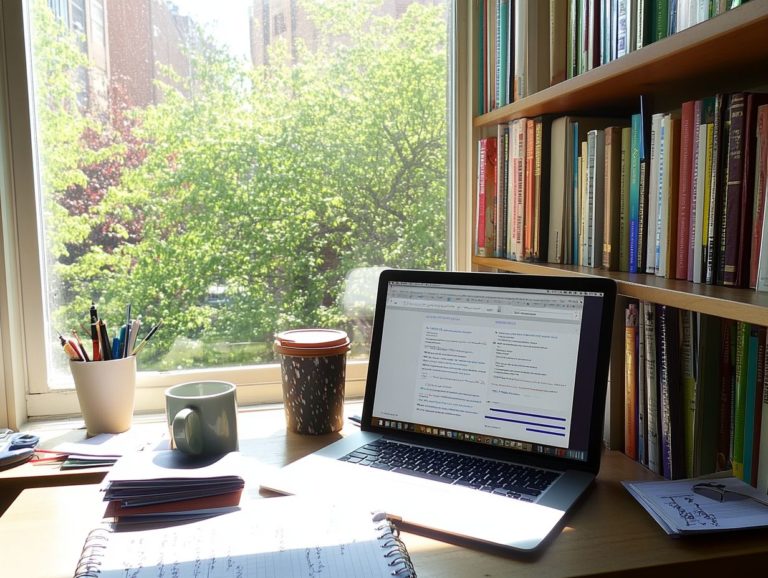How to Prepare for a Scholarship Presentation
Securing a scholarship can be a transformative milestone in your educational journey. However, the application process often hinges on one pivotal aspect: the scholarship presentation.
This guide outlines essential steps to prepare for this critical opportunity. You will explore understanding the scholarship organization, crafting compelling materials, mastering your delivery, and adeptly handling questions.
With the right preparation and insights at your disposal, you will leave a lasting impression and significantly enhance your chances of success. Don t miss this chance to impress the committee!
Contents
- Key Takeaways:
- Understanding the Purpose of a Scholarship Presentation
- Researching the Scholarship Organization
- Preparing Your Presentation Materials
- Practicing Your Presentation
- Tips for a Successful Scholarship Presentation
- Handling Questions and Answers
- Final Preparations and Tips
- Frequently Asked Questions
- What are some tips for preparing for a scholarship presentation?
- How can I make my scholarship presentation stand out?
- Do I need to bring any materials to my scholarship presentation?
- How long should my scholarship presentation be?
- What should I do if I get nervous during my scholarship presentation?
- How can I make a good impression during my scholarship presentation?
Key Takeaways:

- Understand the purpose of a scholarship presentation. It s your chance to showcase your skills, achievements, and goals to the scholarship committee.
- Research the scholarship organization. Understanding their values helps you tailor your presentation and increases your chances of success.
- Practice your delivery. Rehearse, get feedback, and ensure a confident presentation. Arrive early to make a great first impression.
Understanding the Purpose of a Scholarship Presentation
Your scholarship presentation should clearly share your unique qualifications and career goals. This is key to securing vital financial aid.
This is not just about showcasing your academic achievements. It’s your opportunity to engage the audience through compelling storytelling.
What is a Scholarship Presentation?
A scholarship presentation is a formal speech where you showcase your qualifications to the scholarship committee. The goal is to demonstrate your eligibility for financial aid.
Your content should highlight academic achievements, extracurricular activities, and future goals. Engage the audience with storytelling and visuals.
Understanding the specific criteria of the scholarship allows you to tailor your message effectively. By doing this, you foster a personal connection with the evaluators, significantly increasing your chances of standing out in a competitive field.
Researching the Scholarship Organization
Researching the scholarship organization is essential. Understanding their values allows you to create a tailored presentation.
This knowledge enhances your application and sets you apart from other candidates. It shows you are serious about the opportunity.
Understanding the Organization’s Values and Goals
Knowing the organization s values is crucial for your presentation. It helps you align your message with their objectives.
Dive into their mission statement and profiles of past recipients. This will provide insights to tailor your content effectively.
Show how your journey and solutions reflect the organization s mission. This connection demonstrates your fit and increases your chances of success.
Preparing Your Presentation Materials
Preparing your presentation materials is an essential step in securing a successful scholarship presentation. It demands a compelling visual display complemented by well-organized talking points that clearly articulate your qualifications and aspirations during the interview. For additional insights, check out these tips to impress the panel.
This meticulous preparation enhances your confidence and leaves a lasting impression on the selection committee.
Creating a Strong Visual Presentation

Creating a compelling visual presentation is essential for engaging your audience and effectively conveying your scholarship objectives. Use storytelling techniques to enhance understanding and retention.
By thoughtfully integrating visuals and graphics, you can capture attention and illustrate key points dynamically. Develop a cohesive narrative that aligns with your overall goals while resonating with the audience. This fosters an emotional connection, making your content more relatable and memorable.
Utilize whitespace to prevent clutter. This allows your main messages to stand out, making it easier for viewers to focus on essential elements. Tailoring the design to reflect your scholarship’s mission amplifies the persuasive power of your presentation, driving home the core objectives.
Organizing Your Talking Points
Organizing your talking points is crucial for delivering structured responses during your scholarship presentation. This prep helps you communicate your message clearly and confidently, especially when using the STAR method, an approach that showcases your relevant experiences.
This approach encourages you to frame your anecdotes in a way that emphasizes the key skills and experiences relevant to the scholarship criteria. By breaking down your narrative into Situation, Task, Action, and Result, you ll craft a compelling story that articulates your experience effectively.
Practicing these talking points will enhance your confidence, allowing you to speak more naturally and with conviction. Remember, effective storytelling leaves a lasting impression, showcasing your dedication and readiness to embrace new opportunities.
Practicing Your Presentation
Practice your presentation to ensure you shine on the big day! It is essential for mastering both delivery and timing. This ensures your speech resonates with the audience and showcases the dedication you’ve put into preparing for the scholarship competition.
Rehearsing Your Delivery and Timing
Rehearsing your delivery and timing ensures your speech flows seamlessly and engages the audience throughout your scholarship presentation.
Practicing in front of a mirror or recording yourself uncovers subtle nuances in your pacing and helps you pinpoint areas that need refinement. Mastering voice modulation allows you to emphasize key points, making your message resonate more powerfully.
Effective body language like maintaining eye contact and using appropriate gestures fosters a connection with your audience, drawing them into your narrative. Balancing these elements can elevate a simple presentation into a compelling story, ensuring your listeners remain attentive and engaged from beginning to end.
Getting Feedback and Making Adjustments
Receiving feedback and making adjustments is essential for refining your scholarship presentation. It helps you pinpoint areas for improvement that can elevate audience engagement during the scholarship interview.
Constructive criticism from peers or mentors is an invaluable resource, guiding you toward a more polished and impactful delivery. Insights about your pacing, clarity, or even visual aids provide an opportunity to see your work through a fresh lens. This perspective helps you target specific elements that may require more emphasis or clarity, ensuring your message truly resonates with the audience.
By actively incorporating this feedback into your practice sessions, you can enhance your confidence and craft a more compelling narrative that captivates listeners. This ultimately increases your chances of leaving a lasting impression.
Get ready to impress the selection committee with your passion and preparation!
Tips for a Successful Scholarship Presentation
Using key strategies for a successful scholarship presentation helps you connect with the committee, communicate clearly, and engage your audience.
Dos and Don’ts for Presenting to Scholarship Committees

Understand the dos and don’ts of presenting to scholarship committees. This knowledge helps create a memorable presentation and increases your chances of funding, especially when you incorporate tips for writing a scholarship personal statement.
Effective communication is crucial. Speaking clearly and at a measured pace allows you to convey your message persuasively. Maintaining eye contact establishes a connection with your audience and exudes confidence. Avoid the temptation to read directly from your notes; doing so can make you appear disengaged.
Demonstrating genuine enthusiasm for your goals and avoiding an indifferent demeanor fosters a relatable and engaging presence. Striking the right balance between preparation and authenticity is vital for truly resonating with committee members.
Handling Questions and Answers
Navigating questions during your presentation is vital. It shows you can think quickly and respond well in an interview context.
Preparing for and Responding to Questions
Preparing for and responding to questions during your scholarship interview is essential for effectively engaging with the audience and showcasing your confidence.
Anticipate common inquiries about your academic interests, future goals, and motivations for applying. Practicing your responses out loud, perhaps with a friend or family member, can enhance your articulation, ensuring you convey your thoughts clearly.
Make eye contact and actively listen to the interviewers’ follow-up questions to show your genuine interest and engagement. This interaction highlights your communication skills and helps build rapport, making the interview feel more conversational and less intimidating.
Final Preparations and Tips
Make your final preparations count! They can set you apart. Arriving early allows you to set up effectively, ensuring everything is in place.
Maintain a professional demeanor throughout, as it reflects your genuine commitment to this valuable opportunity.
Arriving Early and Setting Up
Arriving early and setting up your technical equipment is crucial for a seamless scholarship presentation. It gives you ample time to troubleshoot any potential hiccups.
By getting there ahead of schedule, you can ensure that all your presentation tools are functioning flawlessly while cultivating a sense of calm and confidence. This thoughtful preparation allows you to concentrate on the content and delivery of your message, creating a professional atmosphere that highlights your commitment and enthusiasm for the opportunity.
This proactive mindset helps you address any potential glitches beforehand and lets you mentally prepare, ultimately boosting your confidence as you engage with the interviewers. This way, you re more likely to leave a lasting impression.
Maintaining Confidence and Professionalism
Maintaining confidence and professionalism during your scholarship presentation is essential for establishing a positive connection with both the audience and the scholarship committee.
To achieve this, consider employing visualization techniques. By mentally rehearsing your presentation in a tranquil environment, you can build a sense of familiarity and ease, helping to reduce anxiety. Pair this with positive affirmations like, “I am prepared and capable,” to foster a powerful mindset.
Professional attire matters; dressing appropriately conveys respect and enhances your self-image. Coupled with confident body language, this can make a significant difference.
Ultimately, by integrating these elements, you’ll create a solid foundation for a successful and memorable presentation.
Frequently Asked Questions

What are some tips for preparing for a scholarship presentation?
- Research the organization offering the scholarship: Understand their values, mission, and goals to tailor your presentation accordingly.
- Review the scholarship requirements: Make sure you meet all the criteria and have all the necessary documentation.
- Practice your presentation: Rehearse in front of a mirror or with friends and family to gain confidence and improve your delivery.
- Dress professionally: First impressions matter, so make sure to dress appropriately for the presentation.
How can I make my scholarship presentation stand out?
- Tell a personal story: Share a personal experience that relates to the scholarship and showcases your passion and determination.
- Use visuals: Incorporate images, graphs, or charts to make your presentation more engaging and memorable.
- Highlight your achievements: Mention any relevant accomplishments or awards that demonstrate your qualifications for the scholarship.
- Be confident and enthusiastic: Show your passion for the scholarship and convey your excitement for the opportunity!
Do I need to bring any materials to my scholarship presentation?
Yes, it is always a good idea to bring copies of your resume, transcripts, letters of recommendation, and any other relevant documents to the presentation. This will show your preparedness and make it easier for the audience to refer to your information.
How long should my scholarship presentation be?
The length of your presentation will depend on the specific requirements set by the scholarship organization. However, aim for a concise and impactful presentation that does not exceed the specified time limit.
What should I do if I get nervous during my scholarship presentation?
Nervousness is natural, but try to stay calm and focus on your presentation. Take deep breaths, speak slowly and clearly, and remember that the audience wants you to succeed. It may help to have note cards or a PowerPoint presentation to refer to if you feel unsure.
How can I make a good impression during my scholarship presentation?
- Be respectful and courteous: Greet the audience with a smile and thank them for the opportunity to present.
- Maintain eye contact: This shows confidence and helps you connect with the audience.
- Speak clearly and confidently: Use a strong and confident tone to convey your message effectively.
- Show gratitude: Be sure to thank the scholarship organization for considering your application and for the opportunity to present.
Get started on your presentation today to make your scholarship dreams a reality!






